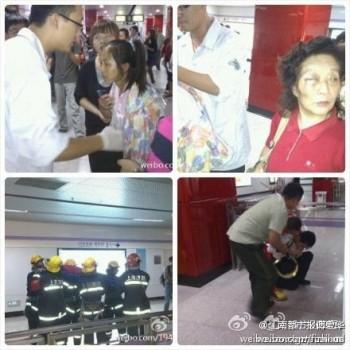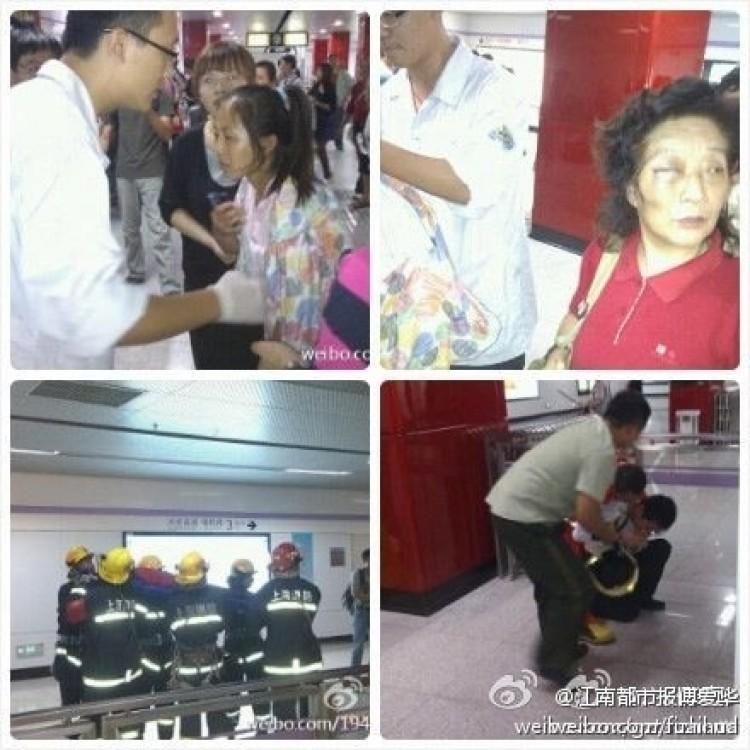While compensation negotiations are still continuing concerning the deadly bullet train crash on July 23 near Wenzhou City, another rear-end collision occurred two months and four days later, this time on the 10 Subway line below Shanghai.
State-owned media first said that a signal malfunction was to blame for the collision; but then published a statement on Sept. 28, attributing the accident to a power failure and operator error.
An engineer familiar with subway safety has characterized the system as unreliable and profit-driven.
The accident happened on Metro Line 10 of Shanghai’s rapidly developing subway system, injuring 284 people. According to information released by the operator, Shanghai Shentong Metro Group, the accident occurred about 40 minutes after a fault in the signal system had forced supervisors to direct trains by telephone.
In an interview with The Epoch Times, Mr. Wei Ming (pseudonym), a train engineer, said, “Human traffic control is not reliable. Men always make mistakes. Machines do the same thing, too. And this is why redundant systems are installed to ensure the overall reliability.
“But in reality, even a redundant system design fails to provide adequate reliability. This newly built subway line has been put into operation without meeting the necessary technical specifications. This is purely profit-driven. At the critical moment when the automatic equipment malfunctions, human control is not reliable, either,” Wei said.
“The distance between 2 subway stations is rather short—around 1 kilometer (0.6 mile). And since the subway operates on a tight schedule, it is truly beyond my imagination that they would dare keep the system running without the protection of a reliable automatic block system and anti-collision system,” he said. “Their decision to operate the system despite equipment failure exposed them to extreme risks.”
According to a preliminary official investigation, the rear end collision in Wenzhou happened because: “Design flaws exist in the signaling device used at Wenzhou South Station. When thunder struck, the signaling device failed and displayed its red light erroneously when it should have been green.”
Yet, analysts believe that government officials have not touched the root cause of the issue.
According to the cover story “Truth of the July 23 Wenzhou Tragedy” published in the Aug. 10 edition of New Epoch Weekly, China’s high-speed trains are equipped with the LKJ monitoring system, which controls the trains via a signal light on the ground, in conjunction with the ATP (Automatic Train Protection) system, which collects the train’s speed and location information from the track. Even though the LKJ system broke down, the ATP system should still have functioned. The Chinese authorities only admitted that the LKJ system malfunctioned but said nothing about the ATP system.
Why do Chinese officials avoid mentioning the train’s ATP system? It is, believes New Epoch Weekly’s Commentator Wang Hua, “because Beijing always claimed that their train designs have employed state-of-the art technologies from different countries, are affordable, and are nearly ready to export to various European and Asian countries. In this Shanghai train collision, officials again claimed that signaling failure at the subway station was at fault, but people must ask, did the ATP system not malfunction as well? Or else the trains wouldn’t collide.”
The July 23rd train tragedy is still under investigation. The signaling systems of the Shanghai Subway line 10 and the Wenzhou collision were made by the same supplier, CASCO Signal Ltd. According to CASCO Signal’s own website, CASCO Signal Ltd. was the first Joint Venture in China’s railway industry, established on March 14, 1986 by the China Railway Signal and Communication Corporation and ALSTOM (China) Investment Company Ltd.
According to a report by the Economic Observer, CASCO supplies the Centralized Traffic Control (CTC) systems to all Chinese railways.
A signal engineer for the CSR Corporation told 21st Century Economic News that because mainland Chinese companies in a joint venture like CASCO Signal lacks its own research and development capabilities, most of the products are copied versions of foreign products. While some of the non-essential parts can be produced in China, the software and software-related core parts are usually supplied by outside companies.
He said, “Due to a lack of understanding across the entire system, it’s unclear whether foreign products are fully compatible with the railway systems in China, so accidents are very likely.”
Read the original Chinese article.
Shanghai Subway Crash Signals Unresolved Safety Problems
While compensation negotiations are still continuing concerning the deadly bullet train crash on July 23 near Wenzhou City, another rear-end collision occurred two months and four days later, this time on the 10 Subway line below Shanghai.

9/29/2011
Updated: 10/1/2015





